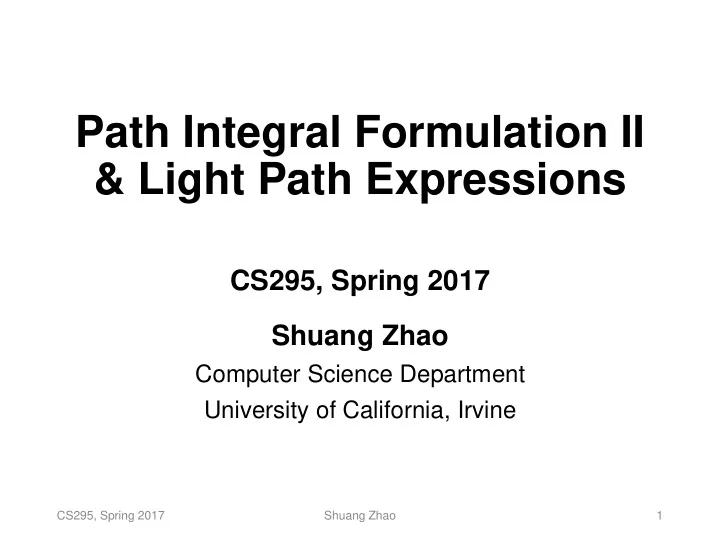

Path Integral Formulation II & Light Path Expressions CS295, Spring 2017 Shuang Zhao Computer Science Department University of California, Irvine CS295, Spring 2017 Shuang Zhao 1
Last Lecture • Path integral formulation CS295, Spring 2017 Shuang Zhao 2
Today’s Lecture • Path integral formulation II • Light path expressions • Hints for implementing path tracing CS295, Spring 2017 Shuang Zhao 3
Recap: Path Integral Formulation where Ω is the path space and for any , and CS295, Spring 2017 Shuang Zhao 4
Recap: Local Path Sampling • The initial vertex is sampled on the light source (based on emitted radiance L e ) or the sensor (based on emitted importance (aka. the measurement function W e ) • From the initial vertex, the path is grown one vertex at a time via a probability density conditioned on the current sub-path CS295, Spring 2017 Shuang Zhao 5
Local Path Sampling • Path tracing • Adjoint particle tracing CS295, Spring 2017 Shuang Zhao 6
Limitations of Local Path Sampling • Certain types of transport paths cannot be sampled • E.g., caustics caused by point lights and curved specular surfaces • In general, the rendering problem is undecidable (using Turing machines) CS295, Spring 2017 Shuang Zhao 7
Regular Expression Notation for Paths • Paths are described using regular expressions of the form L (S|D)* E where • L denotes the endpoint on the light source • E denotes the endpoint on the sensor (or “eye”) • S denotes vertices on “specular” surfaces • D denotes vertices on “diffuse” surfaces CS295, Spring 2017 Shuang Zhao 8
Full-Path Regular Expressions • Extending the notice of S vs. D to the light source and the sensor • Light: L (S|D) (S|D) Position Direction • LDD: a diffusely emitting sphere • LDS: a collimated beam • LSD: a point light • LSS: a laser beam CS295, Spring 2017 Shuang Zhao 9
Full-Path Regular Expressions • Extending the notice of S vs. D to the light source and the sensor • Sensor: (S|D) (S|D) E Direction Position • DDE: a finite-aperture lens • SDE: an orthographic camera • DSE: a pinhole camera • SSE: an idealized spot meter (measuring the radiance along a single ray) CS295, Spring 2017 Shuang Zhao 10
Why using Regular Expression? • S vs. D suggests how certain quantities can be sampled • “Specular” events have to be followed deterministically • “Diffuse” events can be sampled continuously • Remark • Here “diffuse” does NOT imply uniform distributions. Instead, it just means the corresponding functions contain no delta functions CS295, Spring 2017 Shuang Zhao 11
Simulating Caustics Cannot be easily Specular Diffuse obtained! S surface surface L S D S D D S E Point Pinhole light camera LSD D CS295, Spring 2017 Shuang Zhao 12
Possible “Fixes” • Possibility 1: disallowing “specular” events • LDD (diffusely emitting area sources) • DDE (finite-aperture lens) • D (no perfectly specular surfaces) CS295, Spring 2017 Shuang Zhao 13
Possible “Fixes” • Possibility 2: introducing path chains • Example: L S D S D D S E • Each chain has its endpoints being D/L/E and intermediate vertices being S • New methods, called connectors, can be developed to generate individual chains given its endpoints CS295, Spring 2017 Shuang Zhao 14
Connectors • Example 1: planar mirrors (DSD) x' x y CS295, Spring 2017 Shuang Zhao 15
Connectors • Example 2: curved mirrors (DSD) [Mitchell & Hanrahan 1992] CS295, Spring 2017 Shuang Zhao 16
Recommend
More recommend